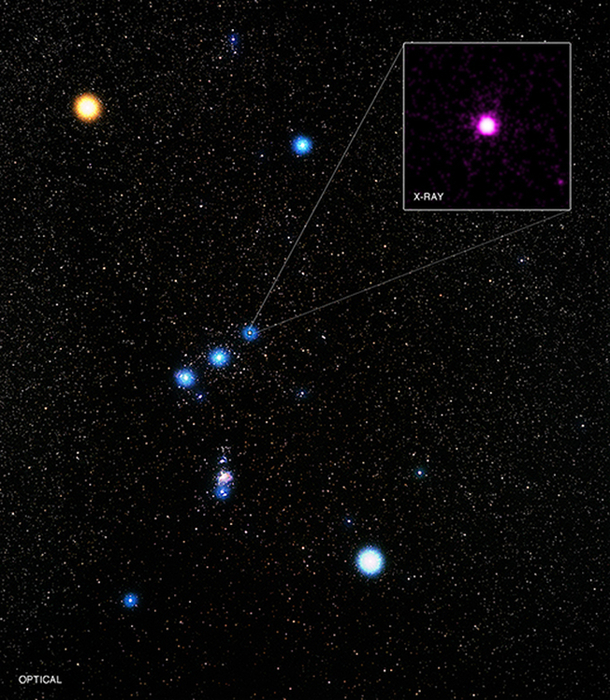
 Credit: X-ray: NASA/CXC/GSFC/M.Corcoran et al.; Optical: Eckhard Slawik
Credit: X-ray: NASA/CXC/GSFC/M.Corcoran et al.; Optical: Eckhard Slawik
An X-ray Wind Shadow
Very rarely, stars are produced with masses of about 10 times the mass of the sun or more. Because such massive stars are rare, and because the nearest of them are hundreds of lightyears from earth, they are rather mysterious objects. These massive stars are so bright and hot that the force of the light they produce drives material off their surface, producing powerful stellar winds blowing at speeds of millions of miles per hour. In addition to producing strong optical and ultraviolet light from their surfaces, these massive stars also produce high-energy X-rays. This X-ray emission is believed to come from hot shocked gas embedded in the strong, turbulent, unstable stellar winds. Studies since the 1980's have helped astronomers characterize the temperatures and amount of the hot gas, but how this hot gas is produced is still poorly understood. A new X-ray study of a nearby massive binary star has allowed astronomers to directly probe the location of the hot gas in the wind of a massive star. This star is a component of Delta Orionis, the westernmost star in the belt of Orion. If observed with a small telescope, this apparently single star can be resolved into a small cluster of three objects. The brightest of these three, called Delta Ori A, is actually itself composed of three stars bound together by their mutual gravity. An inner pair of massive stars orbits their common center of mass with a period of only 5.7 days; a third, more distant star orbits this inner pair, taking about 350 years to make a single complete orbit. The short-period, inner binary consists of a bright, massive star, about 20 times the mass of the Sun, and a lower mass star, about half as massive as the brighter star. The more massive star has a very strong stellar wind, and is a bright X-ray source. The lower-mass star has only a weak wind, and produces very little X-ray emission. Because the lower-mass star is effectively X-ray dark, it casts an X-ray shadow in the wind of the more massive star, as seen from earth. Using the Chandra X-ray Observatory over nearly a full, 5.7-day orbital period, astronomers have now watched the detailed changes in the X-ray emission from the more massive star as the shadow of the lower mass star moves through its stellar wind. This study provides, for the first time, direct limits on the location of the hot, X-ray producing gas in the stellar wind of a massive star.
Published: November 30, 2015
<
HEA Dictionary ● Archive
● Search HEAPOW
● Other Languages
● HEAPOW on Facebook
● Download all Images
● Education ● HEAD
>

Each week the HEASARC
brings you new, exciting and beautiful images from X-ray and Gamma ray
astronomy. Check back each week and be sure to check out the HEAPOW archive!
Last modified Tuesday, 27-Feb-2024 10:10:03 EST


